
Trabzon, historically known as Trebizond, is a city on the Black Sea coast of northeastern Turkey and the capital of Trabzon Province. Trabzon, located on the historical Silk Road, became a melting pot of religions, languages and culture for centuries and a trade gateway to Persia in the southeast and the Caucasus to the northeast. The Venetian and Genoese merchants paid visits to Trabzon during the medieval period and sold silk, linen and woolen fabric. Both republics had merchant colonies within the city – Leonkastron and the former "Venetian castle" – that played a role to Trabzon similar to the one Galata played to Constantinople. Trabzon formed the basis of several states in its long history and was the capital city of the Empire of Trebizond between 1204 and 1461. During the early modern period, Trabzon, because of the importance of its port, again became a focal point of trade to Persia and the Caucasus.
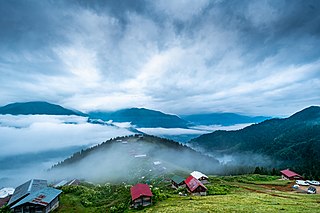
Rize Province is a province of northeast Turkey, on the eastern Black Sea coast between Trabzon and Artvin. The province of Erzurum is to the south. Its area is 3,835 km2, and its population is 344,016 (2022). The capital is the city of Rize. It was formerly known as Lazistan, however the designation of the term of Lazistan was officially banned in 1926.

Erzurum Province is a province and metropolitan municipality in the Eastern Anatolia Region of Turkey. Its area is 25,006 km2, and its population is 749,754 (2022). The capital of the province is the city of Erzurum. It’s the fourth largest province in all of Turkey. It is bordered by the provinces of Kars and Ağrı to the east, Muş and Bingöl to the south, Erzincan and Bayburt to the west, Rize and Artvin to the north and Ardahan to the northeast. The governor of the province is Mustafa Çiftçi, appointed in August 2023. The province has an overall Turkish-majority.

Trabzon Province is a province and metropolitan municipality of Turkey on the Black Sea coast. Its area is 4,628 km2, and its population is 818,023 (2022). Located in a strategically important region, Trabzon is one of the oldest trade port cities in Anatolia. Neighbouring provinces are Giresun to the west, Gümüşhane to the southwest, Bayburt to the southeast and Rize to the east. Aziz Yıldırım was appointed Governor of the province in August 2023. The capital of the province is Trabzon.

Rize is a coastal city in the eastern part of the Black Sea Region of Turkey. It is the seat of Rize Province and Rize District. Its population is 119,828 (2021). Rize is a typical Turkish provincial capital with little in the way of nightlife or entertainment. Since the border with Georgia was opened in the early 1990s, the Black Sea coast road has been widened and the town is much wealthier than it used to be. Current Turkish President Recep Tayyip Erdoğan's family has its roots in Rize and the local university is named after him. The city is linked by road with Trabzon, Hopa (55 miles [88 km] east on the Georgian border, and Erzurum. Rize–Artvin Airport started operating in 2022.
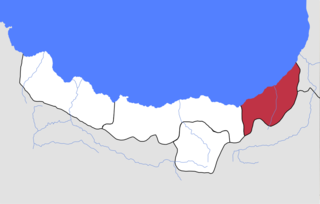
Lazistan was the Ottoman administrative name for the sanjak, under Trebizond Vilayet, comprising the Laz or Lazuri-speaking population on the southeastern shore of the Black Sea. It covered modern day land of contemporary Rize Province and the littoral of contemporary Artvin Province.
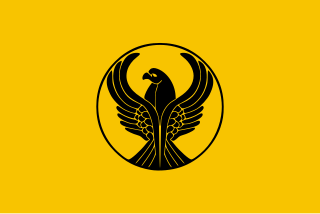
The Pontic Greeks, also Pontian Greeks or simply Pontians, are an ethnically Greek group indigenous to the region of Pontus, in northeastern Anatolia. Many later migrated in various waves between the Ottoman conquest of the Empire of Trebizond in 1461 and the Russo-Turkish War of 1828–1829. Common migratory destinations included other parts of Eastern Anatolia, the former Russian province of Kars Oblast in the Transcaucasus, and the country of Georgia.

The Battle of Sarikamish was an engagement between the Russian and Ottoman empires during World War I. It took place from December 22, 1914, to January 17, 1915, as part of the Caucasus campaign.

The Erzurum offensive or Battle of Erzurum was a major winter offensive by the Imperial Russian Army on the Caucasus Campaign, during the First World War that led to the capture of the strategic city of Erzurum. The Ottoman forces, in winter quarters, suffered a series of unexpected reverses, which led to a Russian victory.
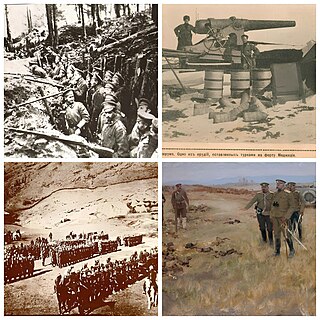
The Caucasus campaign comprised armed conflicts between the Russian Empire and the Ottoman Empire, later including Armenia, Azerbaijan, Georgia, the Mountainous Republic of the Northern Caucasus, the German Empire, the Central Caspian Dictatorship, and the British Empire, as part of the Middle Eastern theatre during World War I. The Caucasus campaign extended from the South Caucasus to the Armenian Highlands region, reaching as far as Trabzon, Bitlis, Mush and Van. The land warfare was accompanied by naval engagements in the Black Sea.

The Vilayet of Trebizond was a first-level administrative division (vilayet) in the north-eastern part of the Ottoman Empire, corresponding to the area along the eastern Black Sea coastline and the interior highland region of the Pontic Alps.

Bulancak is a town in Giresun Province on the Black Sea coast of Turkey, near the city of Giresun. Its former name is Terastios. It is the seat of Bulancak District. Its population is 49,053 (2022).

Akçaabat is a municipality and district of Trabzon Province, Turkey. Its area is 375 km2, and its population is 129,290 (2022). It lies on the Black Sea coast, to the west of the city of Trabzon. Its elevation is ten metres (33 ft). Akçaabat is a coastal town known for its local soccer team Akçaabat Sebatspor, its kofta dish Akçaabat köfte and the Akçaabat Horonu dance. Akçaabat has hosted an international folklore festival since 1990, and it was a venue for Archery and Athletics competitions of the First Black Sea Games held in 2007.
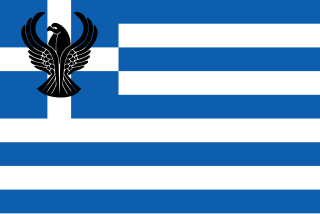
The Republic of Pontus was a proposed Pontic Greek state on the southern coast of the Black Sea. Its territory would have encompassed much of historical Pontus in north-eastern Asia Minor, and today forms part of Turkey's Black Sea Region. The proposed state was discussed at the Paris Peace Conference of 1919, but the Greek government of Eleftherios Venizelos feared the precarious position of such a state and so it was included instead in the larger proposed state of Wilsonian Armenia. Ultimately, however, neither state came into existence and the Pontic Greek population was massacred and expelled from Turkey after 1922 and resettled in the Soviet Union or in Macedonia, Greece. This state of affairs was later formally recognized as part of the population exchange between Greece and Turkey in 1923. In modern Greek political circles, the exchange is seen as inextricable from the contemporaneous Greek genocide.
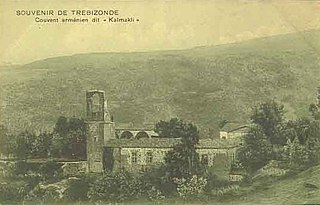
Kaymaklı Monastery is a ruined Armenian Apostolic monastery near Trabzon, Turkey.
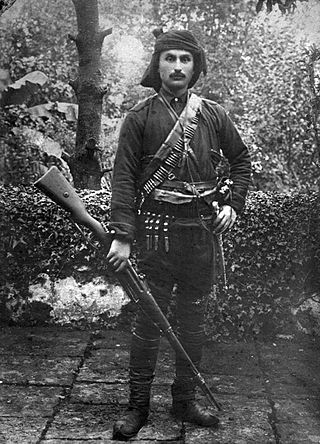
Hacı Topal Osman Ağa also known as Osman the Lame, was a Turkish officer, a militia leader of the National Forces, a volunteer regiment commander of the Turkish army during the Turkish War of Independence who eventually rose to the rank of lieutenant colonel, and was a perpetrator of the Armenian and Pontic genocides.
The Karadere is a river that empties into the Black Sea 20 miles east of Trabzon, Turkey. In ancient times it was known as the Hyssos or Hyssus.

Vazelon Monastery is a ruin located in the Black Sea region of Turkey. It was built in 270 and is 40 km (25 mi) south of Trabzon. Justinian I, a ruler of the Byzantine Empire, ordered the monastery to be repaired in 565, and it was renovated multiple times until the 20th century. The current structures date from the rebuilding in 1410.

Trebizond was a city in the Ottoman Empire where the Armenian genocide occurred. The method employed to kill was mainly by mass drowning, resulting in estimated deaths of 50,000 Armenians. The city was also an important location of subsequent trials held to prosecute those involved with the systematic massacre. Cemal Azmi, the governor of Trebizond during the genocide, was later assassinated as part of Operation Nemesis.
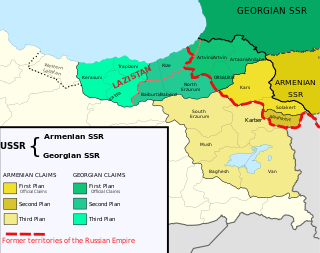
According to the memories of Nikita Khrushchev, the deputy premier Lavrentiy Beria (1946–1953) pressed Joseph Stalin to claim eastern Anatolian territory that had supposedly been stolen from Georgia by the Turks. For practical reasons, the Soviet claims, if successful, would have strengthened the state's position around the Black Sea and would weaken British influence in the Middle East.






















